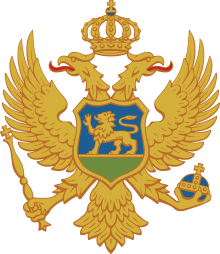Montenegrin independence referendum, 1992
 |
|---|
| This article is part of a series on the politics and government of Montenegro |
| Constitution |
|
Executive |
|
Legislative |
|
Judiciary
|
|
The Montenegrin independence referendum of March 1, 1992 was the first referendum regarding Montenegrin independence. 421,549 citizens were registered voters.
The question put to the electorate was, roughly translated:
Are you for Montenegro to remain a part of a united Yugoslavia, as a sovereign republic and fully equal to all other Yugoslav republics that wish to remain in unity?
The electorate overwhelmingly chose to remain within Yugoslavia, with a Yes vote of 95.96%.
Campaign
Prime Minister Milo Đukanović spent a lot of time campaigning amongst the people, expressing the necessity of a common Yugoslav state with Serbs. Although not generally changing the outcome, DPS-controlled state propaganda had affected greatly by pushing the Federal option and misrepresenting the independenists.
Milo Đukanović's outspoke during the campaign: We are proud of our Serb origin and Montenegrin statehood, the proud history of the Serbian people. That's why we believe in a common future and prosperity.
With the victory of the unionist bloc, he concluded: Because of eternal brotherhood links; common blood spilled in wars, because of the eternal dream of the best Montenegrins and Serbians, for a brightly common better future, Montenegro willingly chose to live in a common state with Serbia with open heart.
The Albanian national minority boycotted the election, as did the pro-sovereigntist orientated Montenegrins.
Blocs
Federation
Supporters
- People's Party (NS)
- Serbian Radical Party (SRS)
Independence
Supporters
- Social Democratic Party of Reformists (SDPR)
- Socialist Party (SP)
Results
Total
Registered Voters: 421,549
- Total: 278,382 (66.04%)
- Yes votes: 266,273 (95.96%)
- No votes: 8,755 (3.14%)
By municipality
Source: Centre for Monitoring[1]
| Municipality | No | Yes | Registered Voters | Voted |
|---|---|---|---|---|
| Andrijevica | 5 (0.11%) | 4,596 (99.61%) | 4,720 | 4,614 (97.75%) |
| Bar | 616 (5%) | 11,523 (93.61%) | 25,550 | 12,309 (48.18%) |
| Berane | 697 (3.99%) | 16,679 (95.37%) | 25,040 | 17,488 (69.84%) |
| Bijelo Polje | 363 (1.65%) | 21,271 (96.75%) | 35,597 | 21,985 (61.76%) |
| Budva | 204 (3.20%) | 6,124 (95.99%) | 8,696 | 6,380 (73.37%) |
| Cetinje | 326 (3.41%) | 9,093 (95.24%) | 14,408 | 9547 (66.26%) |
| Danilovgrad | 93 (1.03%) | 8,092 (89.28%) | 11,319 | 9,064 (80.08%) |
| Herceg Novi | 486 (3.09%) | 15,071 (95.79%) | 21,130 | 15,374 (74.46%) |
| Kolašin | 44 (0.67%) | 6,455 (98.47%) | 8,103 | 6,555 (80.90%) |
| Kotor | 693 (5.83%) | 10,937 (91.98%) | 16,560 | 11,981 (71.81%) |
| Mojkovac | 35 (0.52%) | 6,677 (99.23%) | 7,508 | 6,729 (89.62%) |
| Nikšić | 775 (1.76%) | 43,160 (97.83%) | 52,758 | 44,118 (83.62%) |
| Plav | 96 (3.37%) | 2,730 (95.79%) | 10,314 | 2,850 (27.63%) |
| Plužine | 12 (0.36%) | 3,353 (99.29%) | 3,763 | 3,377 (89.74%) |
| Pljevlja | 452 (2.05%) | 21,543 (97.50%) | 28,573 | 22,095 (77.33%) |
| Podgorica | 2,746 (4.03%) | 64,955 (95.21%) | 103,211 | 68,222 (66.10%) |
| Rožaje | 136 (8.98%) | 1,360 (89.77%) | 13,962 | 1,515 (10.85%) |
| Šavnik | 16 (0.66%) | 2,385 (98.68%) | 2,731 | 2,417 (88.50%) |
| Tivat | 720 (12.37%) | 4,915 (84.44%) | 8,737 | 5,821 (66.62%) |
| Ulcinj | 215 (7.98%) | 2,411 (89.50%) | 15,363 | 2,694 (17.54%) |
References
- ↑ "Zvanični rezultati referenduma 1992. godine". CEMI. Archived from the original on 14 February 2009. Retrieved 21 December 2016.
External links
- (in German) Montenegro (Jugoslawien), 1. März 1992 : Verbleib im jugoslawischen Staatsverband at Database and Search Engine for Direct Democracy